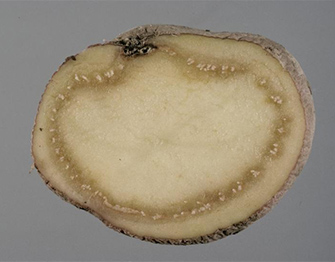Please click here to access the main AHDB website and other sectors.
- Home
- Knowledge library
- Brown rot
Brown rot

Notifiable disease
Potato brown rot poses a serious threat to GB potato production and vigilance is required to prevent its introduction and spread. Several isolated cases have occurred linked to the presence of the causative bacterium (Ralstonia solanacearum) in certain watercourses.
Symptoms
Symptom expression is favoured by warm temperatures and high soil moisture. Early symptoms in the field can include wilting of the youngest leaflets at the ends of the leaves during the hottest part of the day, plants may appear to recover at night as temperatures cool. In cool climate wilting does not always occur. Under favourable conditions the disease develops, leading to stunting of plants, general wilting and yellowing of foliage and eventual plant death. If the stem is cut a mass of white bacterial slime may exude from the vascular tissue.
Symptoms are most obvious in the tuber; initially a brown staining of the vascular ring (hence brown rot) starting at the stolon end, with further disease progression the vascular tissue rots away completely and a pale coloured sticky ooze may appear at the eyes lenticels and/or stolon end of the tuber to which soil may adhere.
Conditions
Brown rot is mainly tuber-borne as it can latently infect tubers and survive in seed tubers during storage, causing disease when planted in the next season. The bacterium can also be spread on machinery and in irrigation water. The disease can also persist in fields where infected groundkeepers are present.
Alternative hosts
Solanum dulcamara and other alternate hosts are epidemiologically important as they may be latently infected and provide inoculum particularly into watercourses.
Control
- The spread of brown rot is through distribution and planting of infected seed potatoes
- Irrigation from contaminated water courses can infect healthy potato crops
- The bacterium can survive from season to season in potato groundkeepers
- Contamination of watercourses can occur through discharge of untreated waste from imported, infected ware potatoes
- Spread may occur via contaminated equipment or from waste dumps containing contaminated material

